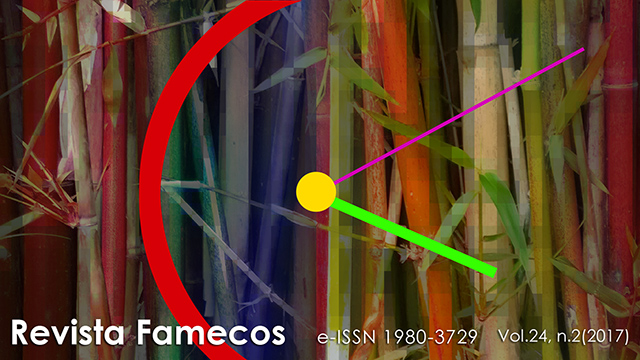The Hateful Eight: A Semiotic-Systemic-Psychoanalitical Analysis
DOI:
https://doi.org/10.15448/1980-3729.2017.2.25171Keywords:
Quentin Tarantino, Semiotic-Systemic-Psychoanalitical Analysis, CinemaAbstract
This article aims to analyze the organization of semiotic bundles willing between the shot and the mise-enscène in the recent film of the director and screenwriter Quentin Tarantino. What is proposed is to see how such nuances and gradations of the signs are handled in flux and how this interacts with the viewer. We take as the basis of this analysis the Semiotics of Charles S. Peirce in junction with the Systemic Theory of Edgar Morin, Jorge Vieira and Ilya Prigogine, and Psychoanalysis of Jacques Lacan. At the end it is explained how such interactions and exchanges between the signs evolve by legaliformes attractors that act as an organizational parameters of meaning.Downloads
References
ARISTOTELES. Arte Poética. São Paulo: Martin Claret Editora, 2005.
A ÚLTIMA Gargalhada. Direção e Roteiro: F. W. Murnau. Elenco: Emil Jannings; Emmy Wyda; George Jonh e outros. Alemanha, 1924. 1. filme (87 min).
BASTARDOS Inglórios. Direção e Roteiro: Quentin Tarantino. Elenco: e outros. EUA: Universal Pictures. 2009. 1.filme (153 min.): son; color; 35mm.
CÃES de Aluguel. Direção e Roteiro: Quentin Tarantino. Elenco: Harvey Keitel; Tim Roth; Michael Madsen e outros. Los Angeles: Warner Film: Dist. Warner Bros. 1992. 1. filme (99 min.): son; color; 16mm.
DANCYGER, Ken. Técnicas de Edição para Cinema e Vídeo – História, teoria e prática. Rio de Janeiro: Editora Elsevier, 2003.
DJANGO Livre. Direção e Roteiro: Quentin Tarantino. Elenco: Leonardo DiCaprio; Samuel L. Jackson; Christoph Waltz; Jamie Foxx; Kerry Washington; Walton Goggins e outros. EUA: MIRAMAX. 2012. 1. filme (165 min.): son; color; 35mm.
EISNER, Lotte H. A Tela Demoníaca: as influências de Max Reinhardt e do expressionismo. São Paulo: Paz e Terra, 2. ed., 2002.
FIELD, Syd. Os exercícios do roteirista. Rio de Janeiro: Editora Objetiva LTDA, 2001.
LACAN, Jacques. Seminário: livro 1: os escritos técnicos. Rio de Janeiro: Jorge Zahar Editor, 1986.
______. Seminário: livro 2: o eu na teoria de Freud e na técnica da Psicanálise. Rio de Janeiro: Jorge Zahar Editor: 2. ed., 2010.
MCKEE, Robert. Story – Substância, estrutura, estilo e os princípios da escrita de roteiros. Curitiba: Arte & Letra Editora, 2006.
MORIN, Edgar. O Método 1 – a natureza da natureza. Porto Alegre: Sulina, 2008.
______. O Método 2 – a vida da vida. Porto Alegre: Sulina, 2005.
MOURA, Edgar. 50 anos luz, câmara e ação. São Paulo: Ed. SENAC, 1999.
MUNSTERBERG, Hugo. A Atenção. In: A Experiência do Cinema. Rio de Janeiro: Edições Graal: Embrafilmes, 1983.
NOSFERATU. Direção: F. W. Murnau. Roteiro: Henrik Galeen. Elenco: Albert Venohr, Alexander Granach, Eric van Viele, Georg H. Schnell, Greta Schröder, Gustav Botz, Gustav von Wangenheim, John Gottowt, Max Nemetz, Max Schreck, Ruth Landshoff, Wolfgang Heinz. Alemanha, 1922. 1. filme (94 min.): son., preto e branco.; 35mm.
OS OITO odiados. Direção e Roteiro: Quentin Tarantino. Elenco: Samuel L. Jackson; Kurt Russell; Jennifer Jason Leigh e outros. Los Angeles: Warner Film: Dist. Warner Bros. Brasil, 1998. 1. filme (168 min.): son., color.; 70mm.
PEIRCE, Charles S. Semiótica. São Paulo: Perspectiva, 2000.
______. The Essential Peirce - Volume 1. Bloomington: Indiana University Press, 1992.
PRIGOGINE, Ilya. O Fim das Certezas. São Paulo: UNESP, 2011.
REIZ, Karel; MILLAR, Gavin. A Técnica de Montagem Cinematográfica. Rio de Janeiro: Civilização Brasileira S. A., 1978.
PULP FICTION. Direção e Roteiro: Quentin Tarantino. Elenco: John Travolta; Samuel L. Jackson; Uma Thurman; Bruce Willis e outros. Los Angeles: Warner Film: Dist. Warner Bros. Brasil, 1998. 1. filme (96 min.): son., color.; 16 mm.
SALLES, Felipe. Bitolas e Formatos no Cinema. Mnemocine, 2009. Disponível em: http://www.mnemocine.com.br/index.php/cinema-categoria/28-tecnica/146-bitolasformatos Acesso em: 2 fev. 2016.
SANTOS, Marcelo Moreira. Do teu Olho sou o Olhar: sobre intenções, mediações e diálogos no cinema. BOCC: Biblioteca On-line de Ciências da Comunicação. 2013. Disponível em: http://www.bocc.ubi.pt/pag/santos-marcelo-2013-doteu-olhar-sou-o-olhar.pdf Acesso em: 13 fev. 2016.
STAM, Robert. Introdução à Teoria do Cinema. Campinas: Papirus, 2003.
STANISLAVSKY, Constantin. A Preparação do Ator. Rio de Janeiro: Record Editora, 15. ed., 1999.
TRUFFAUT, François. Hitchcock/Truffaut: Entrevistas. São Paulo: Companhia das Letras, 2004.
VIEIRA, Jorge de Albuquerque. Ciência – Formas de Conhecimento: Arte e Ciência uma visão a partir da complexidade. Fortaleza: Gráfica e Editora, 2007.
_____. Ontologia – Formas de Conhecimento: Arte e Ciência uma visão a partir da complexidade. Fortaleza: Expressão Gráfica e Editora, 2008.
VOGLER, Christopher. A Jornada do Escritor. Rio de Janeiro: Nova Fronteira, 2011.
XAVIER, Ismail (org.). A Experiência do Cinema. Rio de Janeiro: Edições Graal: Embrafilmes, 1983.
Downloads
Published
How to Cite
Issue
Section
License
Copyright
The submission of originals to Revista Famecos implies the transfer by the authors of the right for publication. Authors retain copyright and grant the journal right of first publication. If the authors wish to include the same data into another publication, they must cite Revista Famecos as the site of original publication.
Creative Commons License
Except where otherwise specified, material published in this journal is licensed under a Creative Commons Attribution 4.0 International license, which allows unrestricted use, distribution and reproduction in any medium, provided the original publication is correctly cited.






